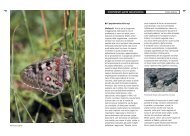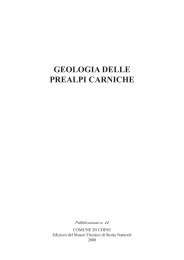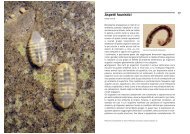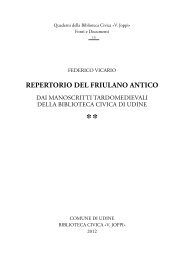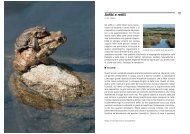Despite its inhospitable appearance and lack of any ... - Udine Cultura
Despite its inhospitable appearance and lack of any ... - Udine Cultura
Despite its inhospitable appearance and lack of any ... - Udine Cultura
You also want an ePaper? Increase the reach of your titles
YUMPU automatically turns print PDFs into web optimized ePapers that Google loves.
112<br />
animal groups still living on the surface. However, since the chronology <strong>of</strong><br />
colonisation <strong>and</strong> speciation is hard to establish, a solution has been found in<br />
the so-called “molecular clocks”, which synchronise DNA mutations in living<br />
organisms with palaeogeographical <strong>and</strong> palaeoclimatic events. An example is<br />
afforded by the examination <strong>of</strong> Sardinian, Provençal <strong>and</strong> Tuscan species <strong>of</strong><br />
stenasellid isopods, living evidence <strong>of</strong> the ancient tectonic fragmentation <strong>of</strong><br />
the Tyrrhenian plate <strong>and</strong> drifting <strong>of</strong> the Sardinian-Corsican continental plate<br />
<strong>and</strong> <strong>its</strong> fragments from what is now Provence towards present-day Italy.<br />
Although necessary for speciation, vicariance (i.e., the splitting <strong>of</strong> the area <strong>of</strong><br />
the old species into two parts separated by boundaries) is not only associated<br />
with these ancient, wide-ranging events, <strong>and</strong> may occur on <strong>any</strong> scale, from<br />
small, isolated fractures in karstic systems, to continents. Vicariant events may<br />
be geoclimatic <strong>and</strong> ecological: obviously, the efficiency <strong>of</strong> these “boundaries”<br />
is closely related to the ecology <strong>of</strong> the species, especially their aptitude for<br />
dispersal. M<strong>any</strong> stygobiont species are not prone to dispersal, <strong>and</strong> show<br />
Affinities between Provençal, Sardinian-Corsican <strong>and</strong> coastal Tyrrhenian fauna are explained by their<br />
common palaeogeographic history<br />
Niphargus similis, found in relict sites in glacialised areas <strong>of</strong> the Alpine chain<br />
limited geographic distribution (they are strict endemics). Furthermore, the low<br />
fecundity, benthic larval development <strong>and</strong> low dispersal potential <strong>of</strong> m<strong>any</strong><br />
interstitial crustaceans suggest that continuous <strong>and</strong> jump dispersal are quite<br />
rare in these groups. This is why stygobionts can be used as excellent<br />
historical (palaeogeographical) indicators, their descriptive capacity being<br />
similar to that <strong>of</strong> true fossils.<br />
Among the events that modelled present-day Italian styg<strong>of</strong>auna, the best<br />
known are certainly glaciations <strong>and</strong> sea regressions. The Quaternary<br />
glaciations depleted underground fauna in large areas <strong>of</strong> Italy, thus leading to<br />
the total absence <strong>of</strong> entire stygobiont genera <strong>of</strong> gastropods, copepods,<br />
isopods <strong>and</strong> amphipods north <strong>of</strong> the boundary <strong>of</strong> the Würmian glaciation. Sea<br />
regression, associated with glacial eustatism, trapped several taxa in coastal<br />
sediments, giving rise to stygobization. Very ancient regressive events led<br />
fauna <strong>of</strong> marine origin to become relicts, enigmatically confined <strong>and</strong> unevenly<br />
distributed in continental groundwater far from coastlines (amphi-Atlantic,<br />
Caribbean-Mediterranean, Caribbean-Mediterranean-Australian). In this case,<br />
the gr<strong>and</strong>iose movements <strong>of</strong> plate tectonics were the main cause <strong>of</strong><br />
relictualisation <strong>and</strong>, in the Mediterranean area, gave rise to the so-called<br />
Tethyan relicts, which date back to the dis<strong>appearance</strong> <strong>of</strong> the ancient Tethys<br />
Sea in the Oligocene.<br />
113




